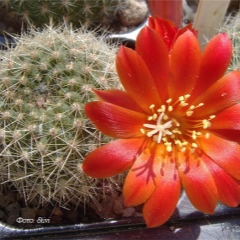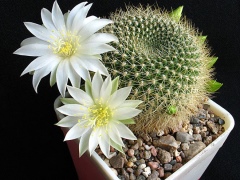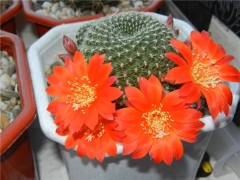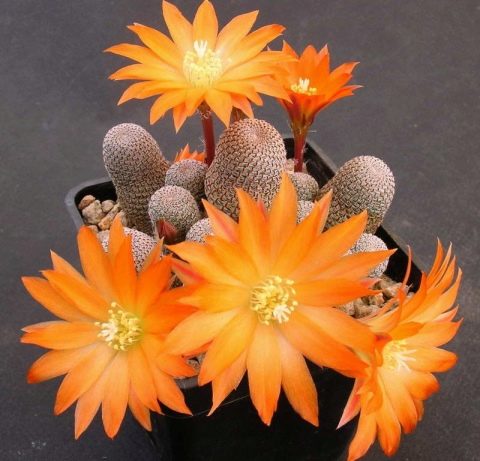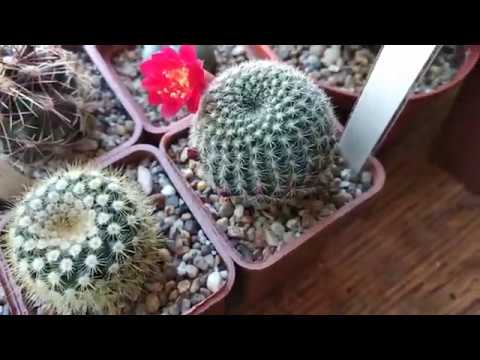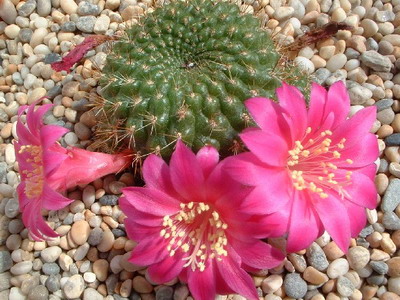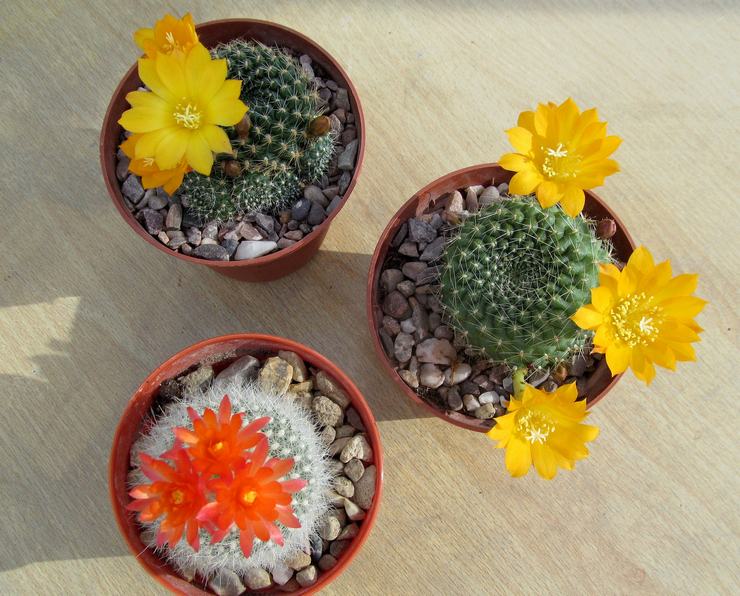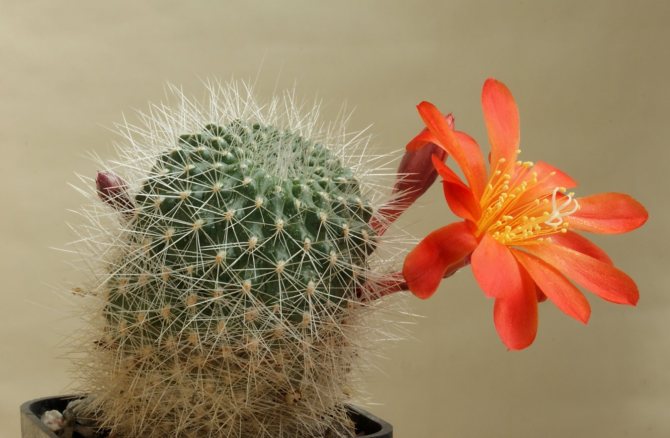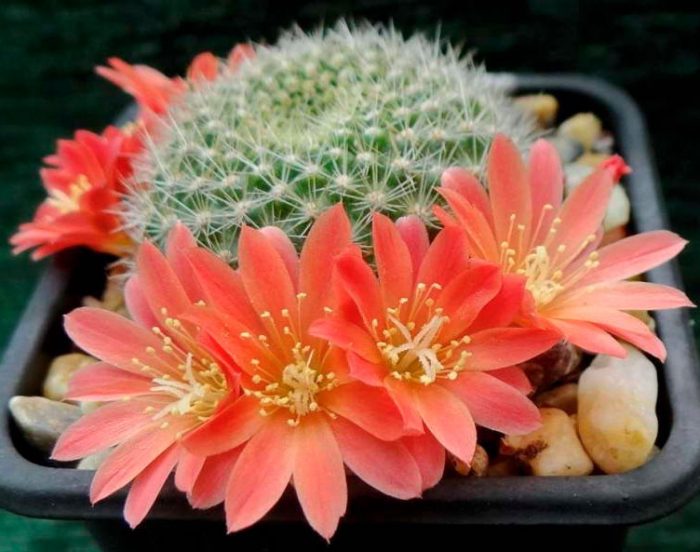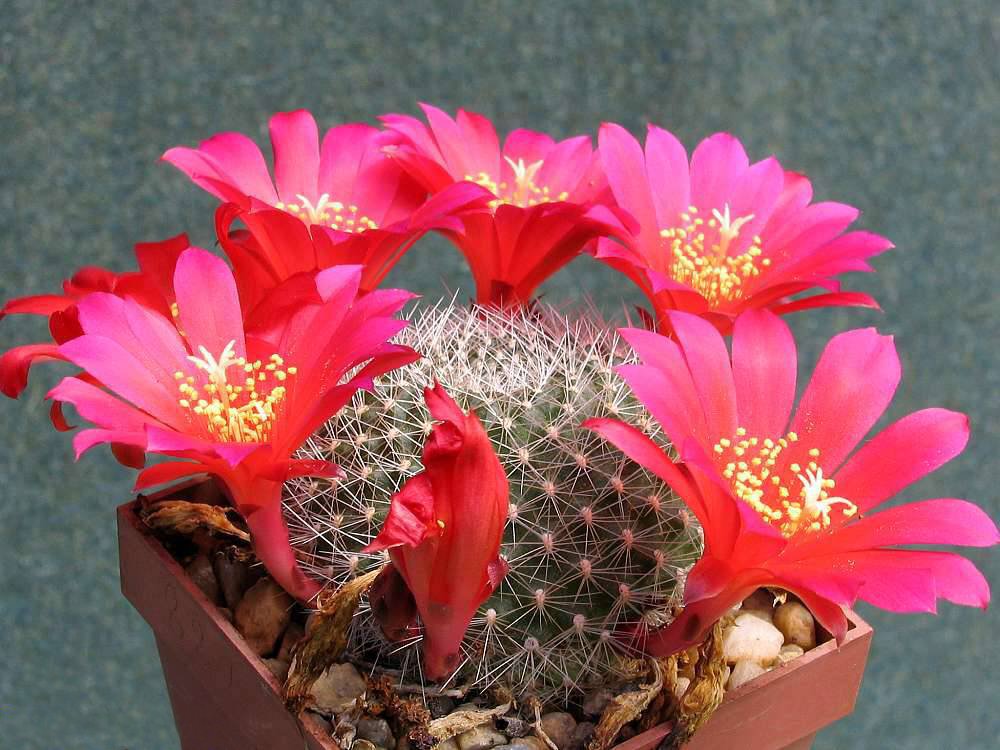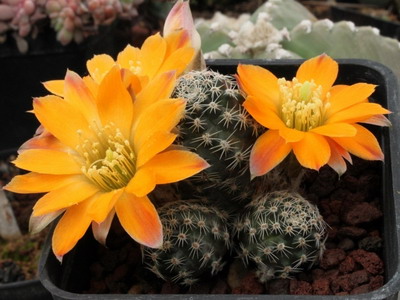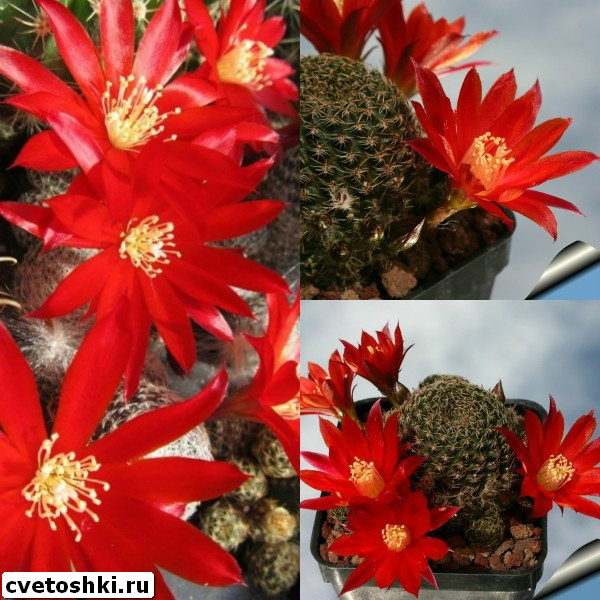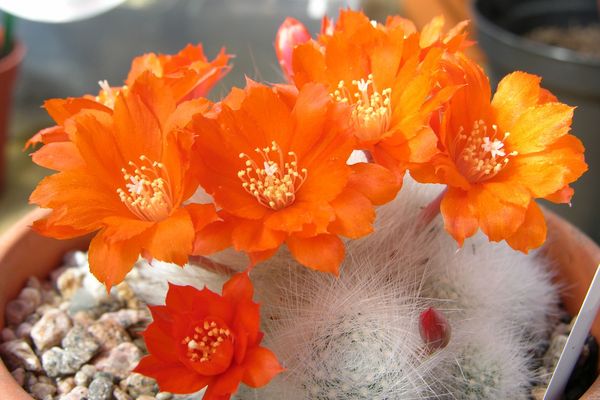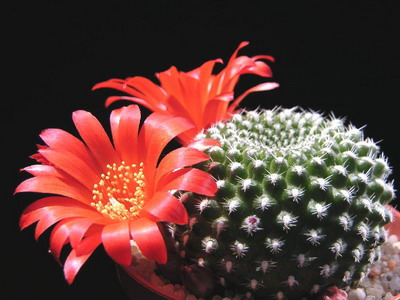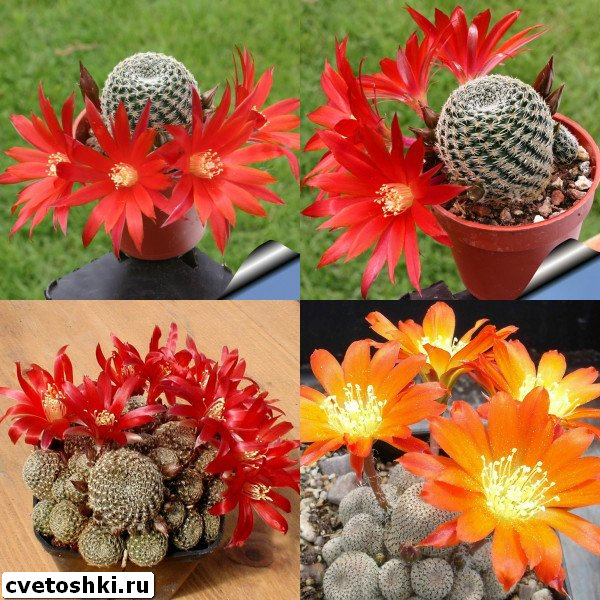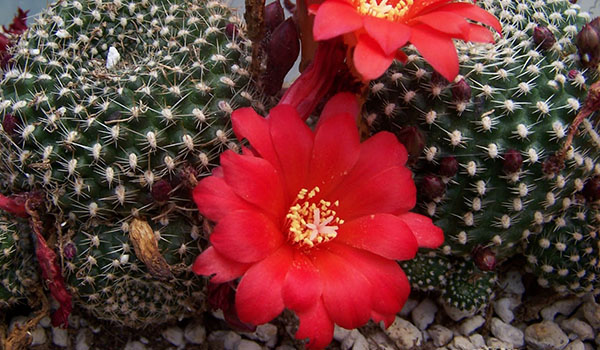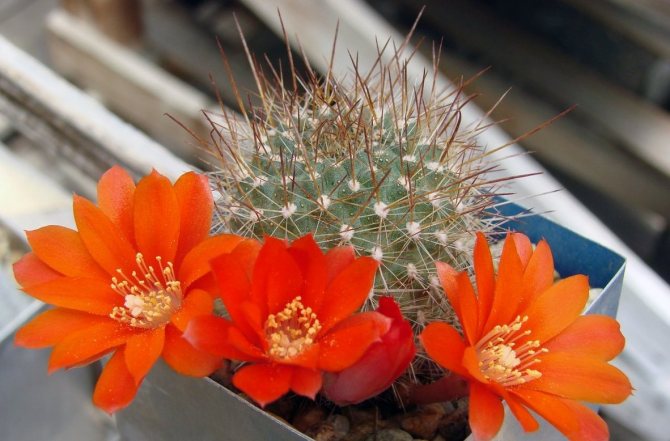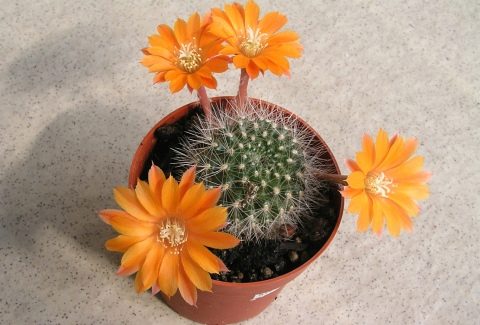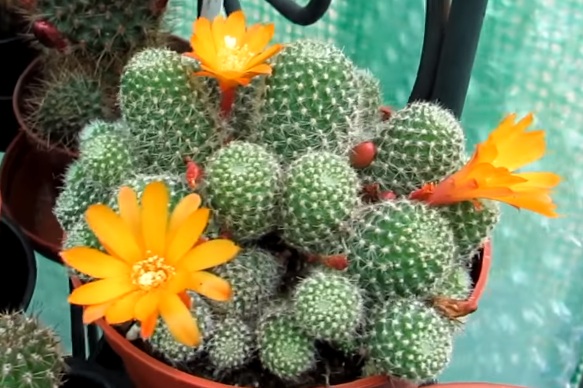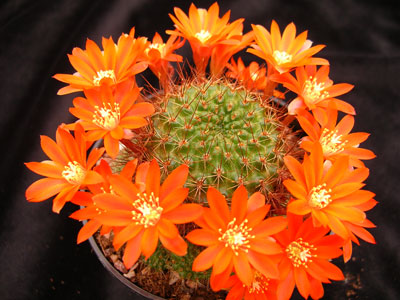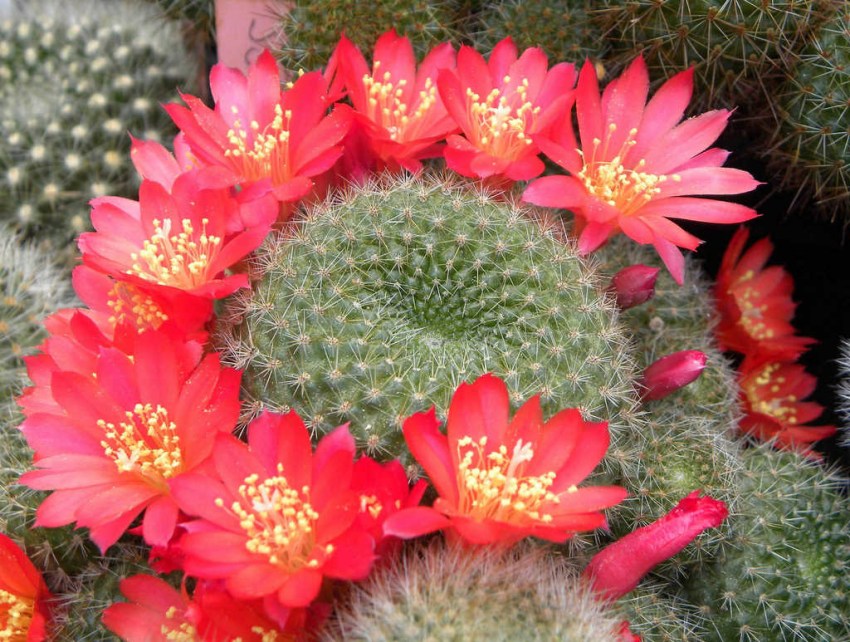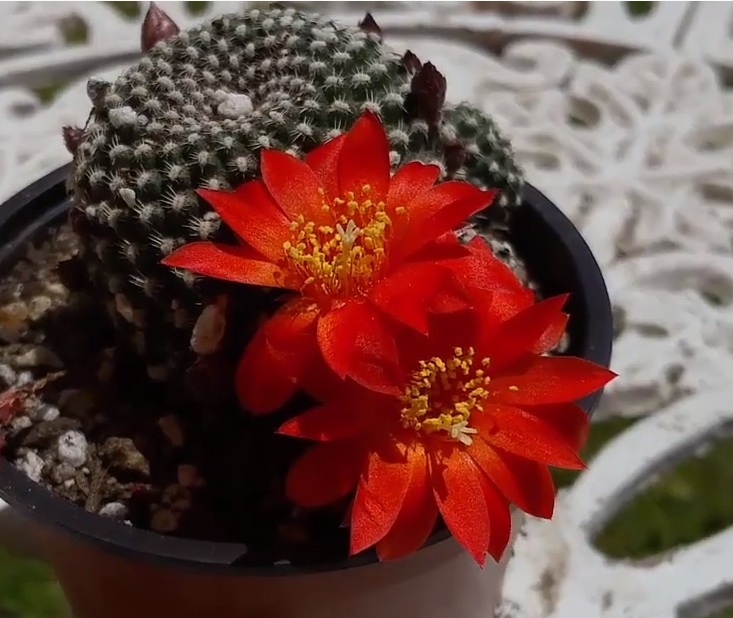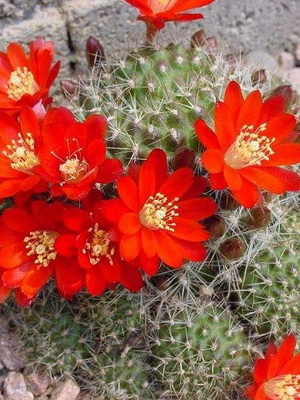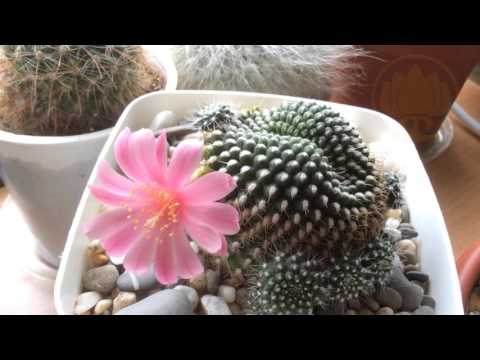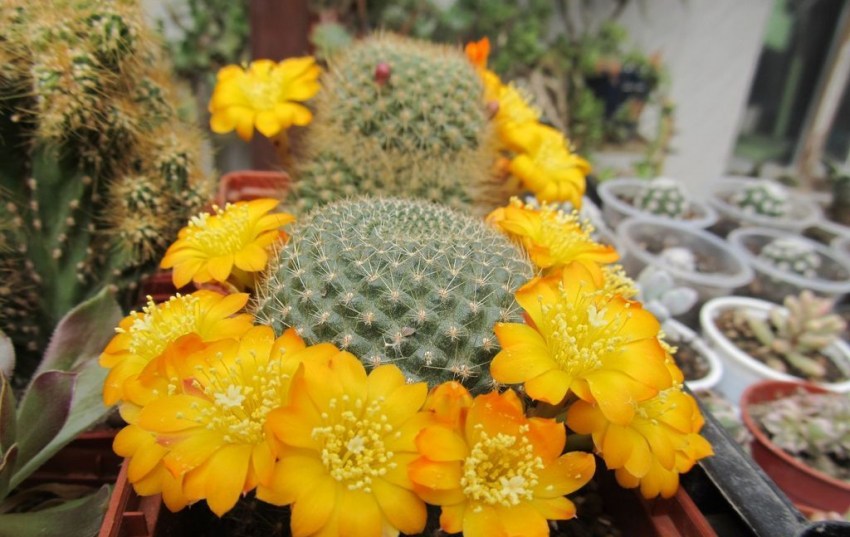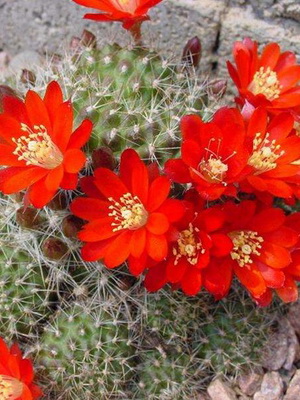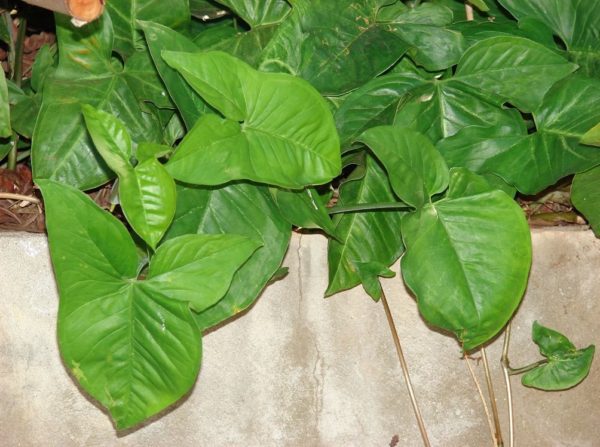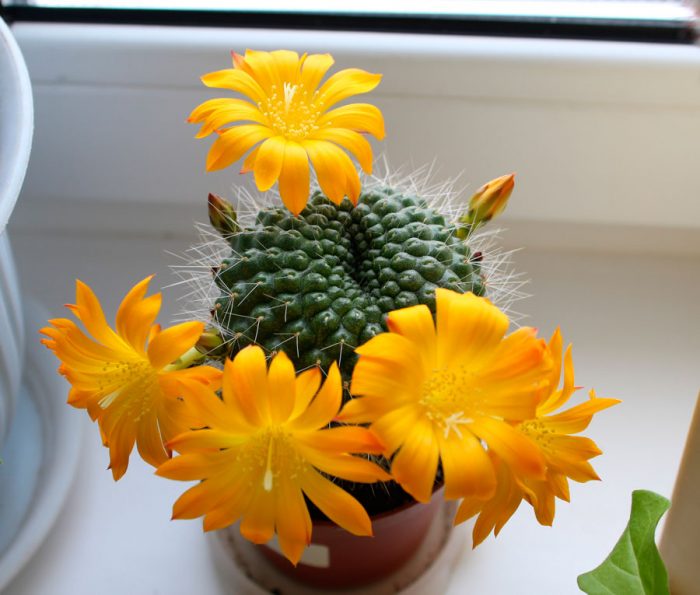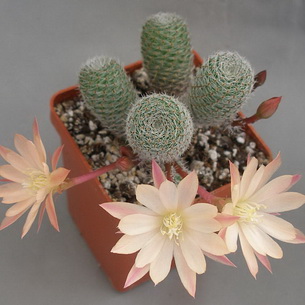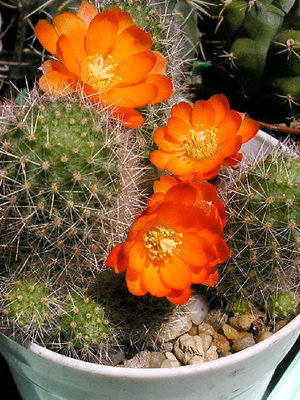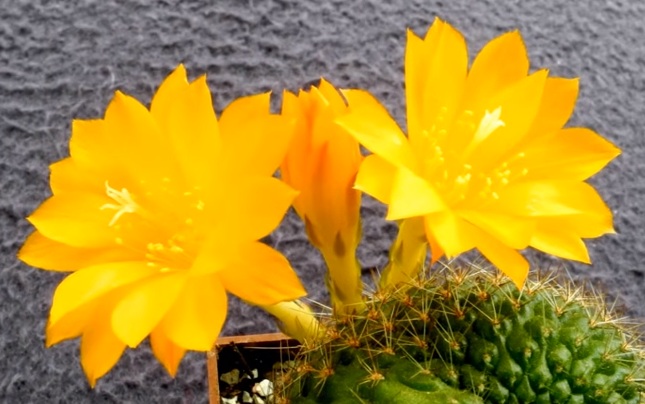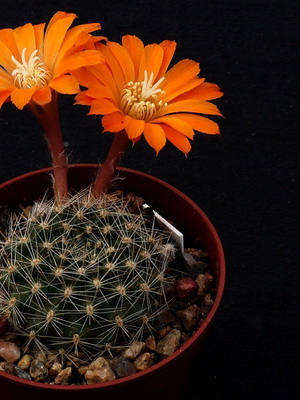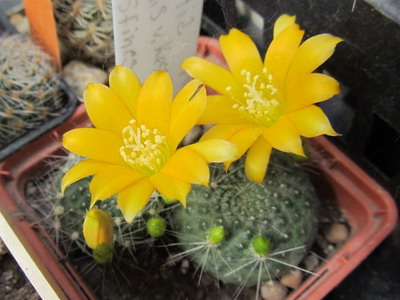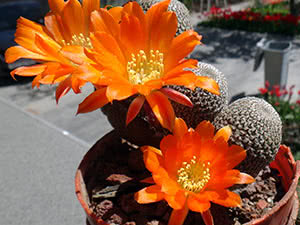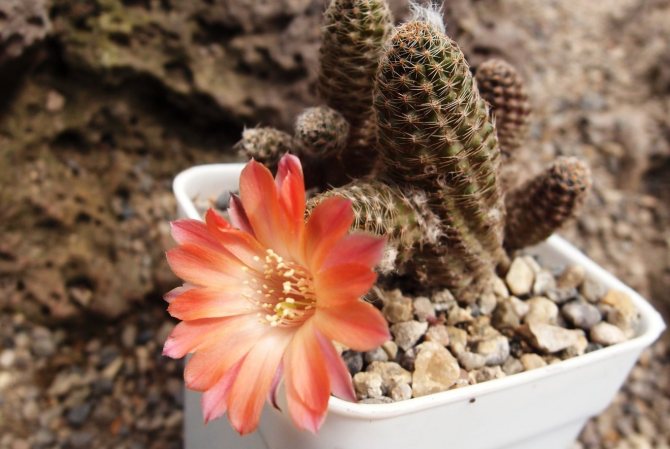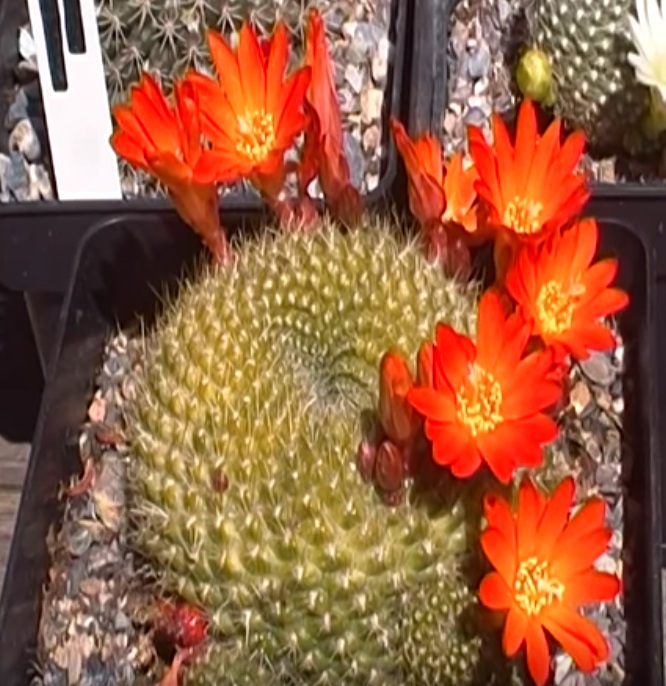Rebutia cactus - care and maintenance at home
Location: The plant needs to provide a lot of light. The cactus tolerates the bright direct rays of the sun. The ideal location is south-east or south-west exposure. In the summer, the cactus is taken out into the open air.
In glazed balconies, or loggias, rebutia can exist all year round.
With insufficient light, the cactus loses its decorative effect, stretches and does not bloom. Often, additional artificial lighting is installed on the north side with fluorescent lamps of a certain spectrum.
But there are some varieties that are adapted to grow in the shade floor. Such species in the spring are not immediately tolerated in open sunlight, but are taught gradually, otherwise there is a high probability of getting burns.
Temperature: A heat-loving plant prefers a hot climate with a temperature of 25-35 ° C in summer. In winter, it is necessary to provide a cold climate of 5-10 ° C. With the onset of spring, during the daytime, the pot can be taken out into the open air, but beware of precipitation. If this is not possible, regularly ventilate the room. The rebutia needs a constant supply of fresh air.
With the onset of autumn, the temperature is gradually reduced, providing the cactus with a state of dormancy. Throughout the winter, they maintain a dry and cold climate with maximum illumination.
If the temperature is too high in winter, flowering will not occur, numerous side shoots appear, and the cactus itself stretches and deforms.
Watering: The cactus tolerates an arid climate well. But at home, it is necessary to provide watering as close to natural conditions as possible. In summer, when the daytime temperature has reached 18 ° C, watering begins abundantly. The next watering is carried out after the top layer of the soil has dried. With the onset of autumn, watering is gradually reduced. In winter, rebutia does not need watering until spring. Occasionally, only young individuals are watered, the diameter of which is 1-2 cm. The water for the plant is used high-quality, settled, distilled, or rainy, without lime. Water temperature for irrigation is 20-24 degrees. Every few waterings, add 2 drops of lemon juice to 1 liter of water.
Humidity: Dry air does not bring inconvenience, but like the natural environment where there is abundant rainfall in summer, it is recommended to spray the cactus with high-quality water from a fine pulverizer during the hot period. Spray during a period when the intensity of the sun decreases, or in the absence of direct sunlight, otherwise burns may appear on the surface.
Soil: The substrate is bought ready-made (for cacti and succulents), or you can prepare it yourself: river sand, turf and leaf land taken in equal proportions. The main requirement is that the soil must pass water and air well. A heavy substrate will not work.
Top dressing: Fertilizer is applied during the period of active growth once a month. Use commercially available cactus fertilizers. In winter, the rebutia is not fed. An excess of nitrogen leads to root rot. Required ratio: Nitrogen 9, Phosphorus 18, Potassium 25.
Transfer: There is no exact period for the plant, it all depends on your climatic zone. The correct time to transplant is to start growing after a dormant period. Varieties that bloom very early are transplanted after flowering.
Young individuals are transplanted once a year, adults are transplanted every 3 years, or as needed if the roots are falling out of the pot. A week before the transplant, watering is stopped and rebution (like other cacti) is transplanted from dry soil to dry. Watering is resumed after a week.All this time, the pot should be in the shade floor, or shade (without direct sunlight).
The soil is used above listed from river sand, sod and leafy land.
Be sure to lay a layer of expanded clay on the bottom of the pot as drainage.
How to care for a cactus
Now is the time to figure out how to care for the rebution. It all starts with drawing up the correct soil and choosing a place to place the pot:
We select the soil
Even if you prefer to buy ready-made soil in the store, you need to pay attention to the composition of the selected soil. It must contain such components as:
It must contain such components as:
- Turf. Such soil is literally necessary for cacti.
- Charcoal, only wood, which improves the distribution of moisture and beneficial trace elements throughout the flowerpot.
- Leafy soil. An important component of the soil for a cactus.
- Granite chips. It is not easy to get such a component on your own, but it is very important for the health of your plant, since it provides decent drainage of all soil.
Sod and leafy soil should form the base of the mixture, correct proportions involve moderate use of coal and granite chips. The rebution has no preferences in the materials from which the pot should be made.
Choose a beautiful and stable pot, we recommend taking plastic, as it is lighter and more reliable than ceramics or glass. You can place the flowerpot even in the sunniest place, since the natural habitats of the cactus have adapted it to the scorching sun.

Lighting and moisture
We have already touched on the topic of lighting, it is necessary to reveal in more detail the needs of rebution in light
Direct and scattered rays provide the same amount of benefit, but in the heat of summer it is important to protect the plant from sunburn. Ventilate the room, and then the rebution will be in great health.
Regarding moisture, everything is simple: it is better to overdry the rebution than to pour the plant with water. Watering is carried out when the topsoil dries up. Do not forget about the simple rule, which says that at low temperatures, the already rare watering should be reduced so that the plant goes to a quiet winter.
See also the article on the reproduction of Rodophiala.
Fertilizers
When choosing a top dressing, look at the amount of nitrogen. The less of this element in fertilization, the better. It is customary to combine top dressing with watering, so the flower will better absorb fertilizer. But keep in mind that top dressing should be rare for your plant.
Transplant, treatment of diseases
In home, one might say greenhouse, conditions, rebutia grows very quickly, and sooner or later it will be necessary to transplant the plant into a large container. When moving the plant to a new pot, be careful not to damage the roots. If you notice tangles in the root system, carefully separate them. This will direct the growth of the rebution to the correct key.
Possible diseases of the cactus rebutia, in most cases, arise from improper watering. Pests need to be eradicated with special preparations before they harm your plant.
So you have learned everything you need to grow rebutia. Love your plant and it will reciprocate you. We wish you every success!
Reproduction of the cactus rebutia
Rebutia propagates by seeds and side shoots.
Seeds. This method is much harder and more troublesome. Seeds do not need cross-pollination to ripen. After ripening, the semen is harvested and stored in a dry place. At the beginning of March, they are sown in a substrate of sand and leafy earth, taken in equal proportions, and 0.5 parts of charcoal are added. The soil is pre-steamed to avoid larvae and diseases. Immediately before sowing, the seeds are treated for 10-15 minutes in a weak solution of potassium permanganate.
The distance between the seeds is 2 cm. The expanded clay drainage is placed on the bottom of the container.
After sowing, the container is covered with plastic wrap, or placed in a mini greenhouse. The temperature is kept at 16-20 ° C and regularly ventilated and sprayed.
After the sprouts appear, they are dived into separate containers. A year later, young shoots are gradually accustomed to adulthood. Prior to this, it is necessary to protect from direct sunlight and provide a large amount of diffused light.
Watered carefully, young shoots react extremely negatively to excess moisture. Children (side shoots)
Due to the large branching of rebutia, a large number of lateral shoots are formed
Children (side shoots). Due to the large branching of rebutia, a large number of lateral shoots are formed.
Shoots develop independently as separate cacti, but are associated with the mother by a small isthmus. When the shoots are overgrown, they are detached from the mother plant. As a rule, rooting is carried out from spring to the beginning of the dormant period, this is the best period for successful rooting.
Having separated the baby, it is necessary to dry it for a day and plant it in a moist and warm substrate.
The primer must first undergo sterilization. The baby can also be rooted in wet sand.
To preserve the species, the best way to propagate by seeds is by purchasing from specialized stores.
Conditions for flowering
- There is plenty of light in the summer.
- In winter, the temperature is no higher than 10 degrees.
- Correctly selected substrate and the presence of drainage.
- Abundant watering (in moderation) in summer.
- Rare watering in autumn and absence in winter.
Pests: Rebutia is attacked by mealybugs, scale insects, spider mites. For removal, they are treated with purchased solutions (acaricides), the temperature is lowered and watering is reduced.
Diseases and pests
Often, such a cactus is subject to root decay. This happens due to excessive watering, too low temperatures in the room, or due to a large amount of nitrogen in the soil. To avoid root rot, there are some simple rules to follow.
In addition to roots, cactus stems can also rot. This can happen due to frequent watering when the plant is dormant in a cool room. In this case, the soil is no longer moistened until the stem dries up a little.

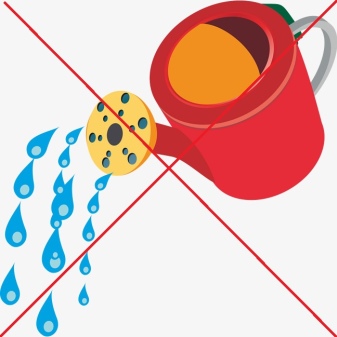
Sometimes cork structures form on the plant. They appear due to significant mechanical damage to the stems. They are also formed due to hypothermia, too little watering during the hot season. A cactus can be damaged by the appearance of a spider mite or mealybug. In this case, you first need to carefully remove all insects from the plant. This is done with a cloth dipped in an alcohol solution.
After removing the parasites, sick cacti should be treated. For this, it is better to use effective chemicals. So, you can use "Actellik" or "Fitoverm". As a preventative measure, you can periodically view the plant and check for pests and sometimes wipe it with a brush dipped in alcohol.
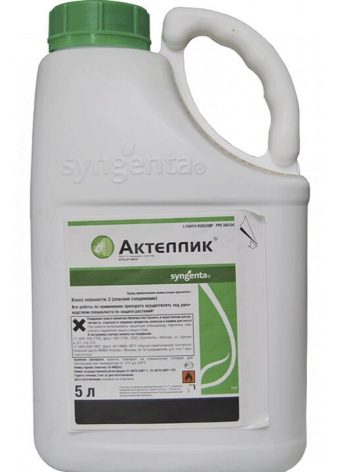
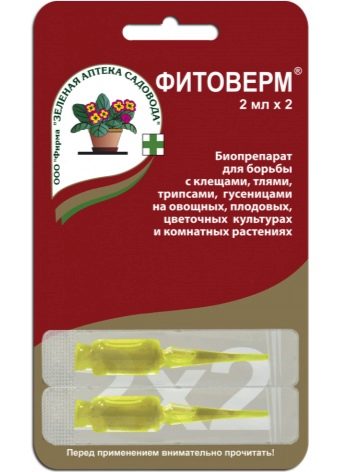
For more information about the cactus of the Rebutia variety, see the next video.
Home care for austrocylindropuntium
For the successful cultivation of austrocylindropuntia, it is enough to remember only one thing - the need to avoid getting the cactus itself wet and dampness of the soil. Caring for this cactus is not simple, but super simple, the absence of mandatory procedures is easy for the cactus and requires minimal care. All care procedures are reduced to several dressings and watering.
Watering and air humidity
These are unique cacti that can be content with really minimal watering. Of course, experimenting with permanently dry soil is not worth it. But austrocylindropuntia will need minimal water procedures. Water the plant so that the substrate dries out almost completely between these procedures. Even in summer, one watering per week is usually sufficient.In spring, autumn and winter, the plant will prefer 2-3 times less watering.
In winter, when kept cool or cold, watering is not carried out; when wintering in warmth, they are made minimal, only after the stems lose turgor. Watering "in several passes" - with light soil saturation is the best option.
Water from the pallet, even if it appears in a minimal amount, is drained immediately, preventing it from accumulating. It is worth watering the plant carefully, without soaking the stems. This plant can also be grown with bottom irrigation.
Austrocylindropunctions not only do not require, but are also afraid of high air humidity. For them, you should carefully choose a place, avoiding the neighborhood with tropical moisture-loving plants.
Top dressing and fertilizer composition
An excess of nutrients is very dangerous for austrocylindropuntia. Plants are fed very rarely, but with a standard dose of fertilizers. The usual strategy is feeding from May to September once a month. If this is more convenient, feeding can be made more frequent, but less concentrated.
For austrocylindropuntia, standard cactus or succulent fertilizers are used.
Particular attention should be paid to trace elements. Universal fertilizers will not work for this plant.
Transplant, containers and substrate
The transplantation of austrocylindropuntium is carried out not annually, but as they develop the soil and container space. Usually, the plant is transplanted no more than 1 time in 2-3 years. Replacement of the topsoil is carried out annually in years without replanting. The optimal time for changing the capacity and substrate is considered early spring (if the cactus is blooming, the transplant is postponed until the end of flowering). Always oriented towards the beginning of growth.
For the cultivation of this type of cacti, it is preferable to use purchased soil mixtures.
When compiling the soil, it is worth checking the quality of all components yourself and paying attention to the disinfection of the substrate
The optimal characteristics of the substrate for austrocylindropuntia are good water permeability, light, loose, fine-grained structure and pH from 6 to 8 with addition of brick chips. The optimum soil composition is coarse sand, soddy soil, leafy soil and peat in a ratio of 3: 2: 2: 2.
Austrocylindropunctions are planted only in containers with large drainage holes and not too deep. Regardless of the substrate or composition, a high drainage layer is laid at the bottom. This cactus can grow in a minimal amount of soil, in stony, sandy, decorative substrates and common decorative and nutritious options for florariums.
Before transplanting, the substrate must stand completely dry for several days. When replanting austrocylindropuntia, it is best to avoid root trauma, but instead of transshipment, it is better to use full extraction. The roots of the cactus must be examined, removing all damaged, dry, and even more rotted areas and processing the sections. After transplanting, watering is resumed no earlier than 1 week later. At the same time, it is better to keep cacti in shade for 7-10 days.
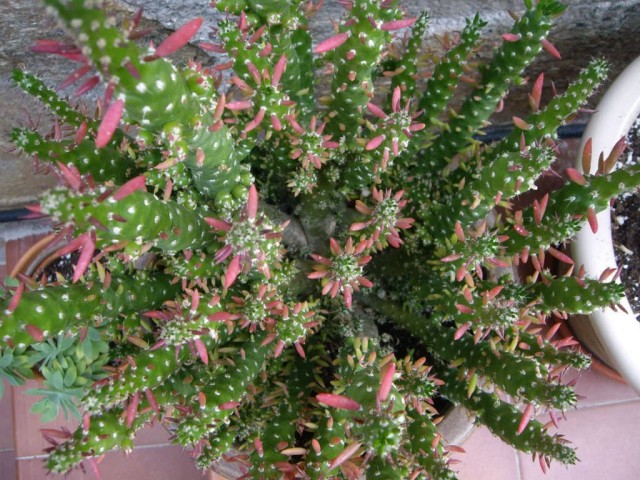 Thanks to the active formation of lateral shoots and children, it is very easy to propagate austrocylindropuntia. World of succulents
Thanks to the active formation of lateral shoots and children, it is very easy to propagate austrocylindropuntia. World of succulents
Indoor types of rebution
The genus is very diverse, so it is rather difficult to list all types of rebuts. Breeders are constantly expanding the range and introducing new hybrid varieties. Looking through the catalog with photo rebutions, it is difficult to make a choice, because each copy has a special charm.
Deminute rebution. The plant has a spherical or oblong stem about 10 cm high and 6-8 cm wide. This species quickly forms daughter plants, so the pot is filled with many beautiful balls. The dark green stem has up to 13 spiral-shaped papillary ribs. Areoles have grayish villi and several stiff needles. The spines are 5-6 mm long.In June-July, many funnel-shaped flowers bloom at the base of the stem. Their diameter does not exceed 3 cm. The red-orange petals are slightly bent back.
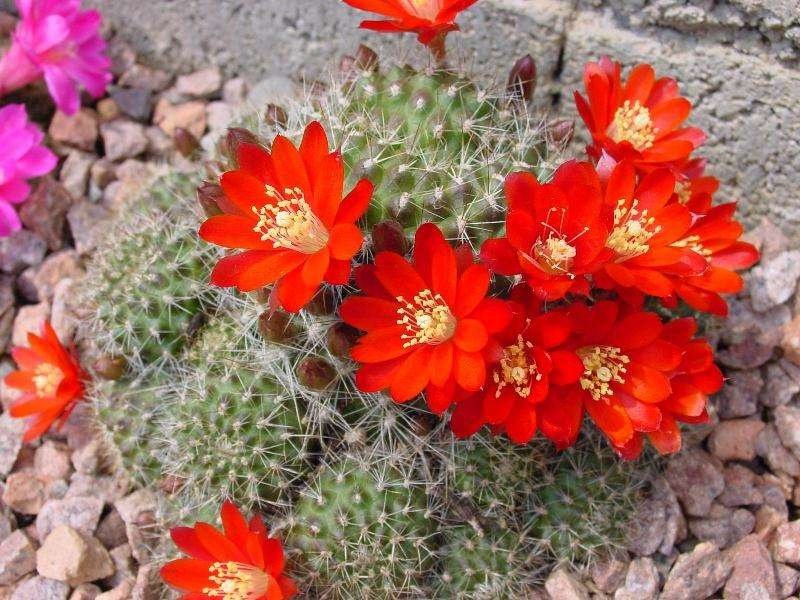 Deminute rebution
Deminute rebution
The rebutia is tiny. The light green stem in the form of a flattened ball does not exceed 5 cm in height. The papillae on it are arranged in a spiral and are covered with short, bristly spines. The needles are colored silver or gold. The red tubular flowers bloom in June and are 3-4 cm in diameter.
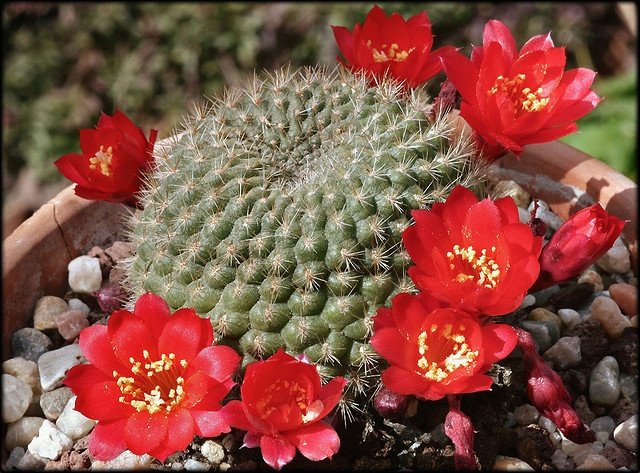 Rebutia is tiny
Rebutia is tiny
Albiflora rebutia or white-flowered. The plant forms a dense clump of many whitish balls. Tiny stems are densely covered with whitish pile. Large flowers with a diameter of about 4 cm exceed the size of the stem. The petals are creamy with pinkish edges.
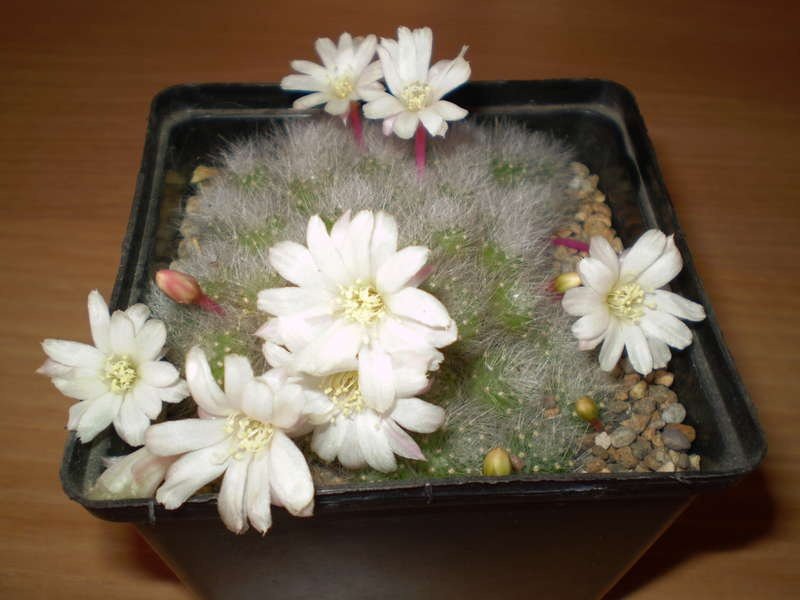 Albiflora rebutia or white-flowered
Albiflora rebutia or white-flowered
The rebution is dwarf. The plant has a cylindrical dark green stem. The spines are located on the papillae in bunches and are pressed against the stem. Its base is covered with large tubular flowers with pink or red petals. Flowers open in May.
 Dwarf rebutia
Dwarf rebutia
Senile rebutia. The globular dark green stem reaches a height of 8 cm and a width of 7 cm. Its surface is densely covered with low papillae with numerous whitish spines. The length of the needles is 3 mm. In spring, the plant produces many red flowers with narrow, strongly curved petals.
 Senile rebutia
Senile rebutia
Rebutia caniguerali. The cactus has the best drought tolerance. The small spherical stem is densely covered with very long, hard spines. Several small flowers are arranged in a wreath at the top of the stem. The bells of flowers consist of whitish petals with a bluish border and a bunch of yellow stamens.
 Rebuzia caniguerali
Rebuzia caniguerali
Rebution of the Mansoner. The plant has compact spherical stems covered with spiral ribs. Large canary flowers are located on the sides and bottom of the stems. All the buds open at the same time, turning the curtain into a small sunny island.
 Rebution of the Mansoner
Rebution of the Mansoner
Mouse rebution. The cactus is a few spiny balls up to 5 cm in diameter. The entire surface is densely covered with whitish spines and looks more like a fluffy coat of an animal. Daytime orange flowers have an elongated tube. The diameter of the open petals is 5 cm.
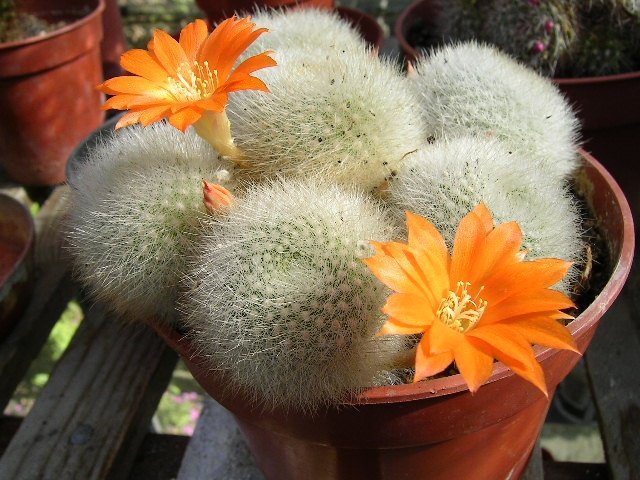 Rebution mouse
Rebution mouse
Rebution of Krajnz. This species does not form a dense curtain and often grows in the form of a single oblong stem. The low ribs are covered with many tubercles with a short whitish pile and long silvery spines. Scarlet flowers are composed of narrow, swirling petals. The buds are grouped not around the stem, but on one side of it.
 Rebuzia of Krajnza
Rebuzia of Krajnza
Home care
Lighting
South facing windows are best suited, with bright year-round lighting and an inevitable dose of direct sunlight.
Specimens with long bristle spines, completely encircling the stem, easily tolerate prolonged sunshine, the rest will need shading on clear summer days.
The exception is the type of perplex, which always prefers partial shade.
Temperature
Because "wild" rebuts grow in desert mountainous areas, rising up to 2500m above sea level.
They like hot summer days (up to plus 38) and moderately warm nights, and in winter - coolness: from 5 to 10 degrees with a plus sign.
In the summer, "vacations" on an open balcony are very useful (a pot of cactus can be temporarily buried in a hanging flower box) or on a garden plot.
In this case, the daily heat drop will be created naturally. In addition, the "highlanders" need fresh air and regular ventilation.
The soil
A special ready-made soil is taken as a planting substrate, or coarse-grained sand is mixed with sod and leafy soil in equal amounts.
It is also good to add granite chips, peat and charcoal pieces.
Landing
Considering that the root system of this genus does not grow deeper, but rather resembles a turnip in outline, you need to choose a shallow but wide container for planting - best of all, ceramic, without continuous glaze.
A large area will help the evaporation of excess moisture and, moreover, will allow a squat colony of stems to branch and grow.
At the bottom of the pot, a thick - up to a third of the volume - drainage layer must be placed: expanded clay, small pebbles or brick battle with pieces of charcoal.
Then the prepared soil is poured and the cactus is placed carefully, without injuring the vulnerable roots. Pour the earthen mixture and gradually compact it
At the same time, the root collar of the succulent is not buried: the body of the cactus should be supported by the upper drainage layer of small pebbles
Pour the earthen mixture and gradually compact it. At the same time, the root collar of the succulent is not buried: the body of the cactus must be supported by the upper drainage layer of small pebbles.
Transfer
As a rule, the transplant is carried out on average once every two years; the need for transplanting is mainly determined by the growth rate of the stem colony.
The best time for transplanting is the spring start of active growth.
If buds have formed at this time, the procedure is postponed until the end of flowering.
When transplanting, they retain the old earthen lump.
This, however, does not apply to purchased copies. As a rule, those succulents that go on sale are grown in special solutions, and the substrate in the container is devoid of nutrients.
Therefore, immediately after the purchase, the purchased specimen is completely freed from the old soil and transplanted into a fresh soil mixture.
Air humidity
Dry air in itself is quite suitable for rebutions, but the operation "mountain dew" - spraying a cloud of water spray from a fine atomizer - will do them good and eliminate the accumulation of dust on the stems
Watering
Spring-summer watering is carried out regularly, after the soil in the pot dries out.
They take soft, well-settled water; can be acidified by dissolving half a teaspoon of citric acid in 7 liters of water.
In mid-September, subject to a cool content, watering of all plants thicker than a centimeter is practically stopped.
On a cold winter, "dry law" reigns all the more, but at 14-18 degrees in winter, rebuties are watered - rarely and very limitedly.
Top dressing
In the season of active growth, fertilizing is carried out with a special fertilizer for flowering succulents.
You can also prepare a weak solution of a complex fertilizer with a low nitrogen content, since an excess of nitrogenous compounds leads to root rot.
Bloom
Unpretentious representatives of the genus bloom annually, brightly and abundantly, if they are healthy and have gone through a cold dry winter. Many species are easy to pollinate and produce seeds. The video below shows the flowering of the Rebutia cactus:
Popular types of rebution
Rebutia is one of the most common decorative cacti in the world. It has many varieties, and breeders are actively creating new hybrids of it. The most popular are:
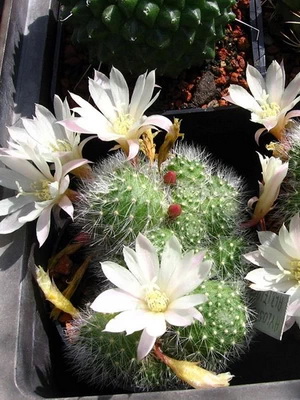
White-flowered rebutia (R. albiflora).

Tiny rebutia (R. minuscula).
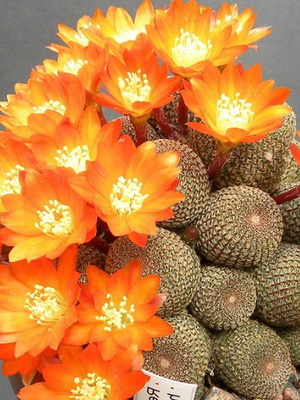
Solar rebutia (R. heliosa).

Rebution Marsoneri (R. marsoneri).

Kupper's rebution (R. kupperiana).
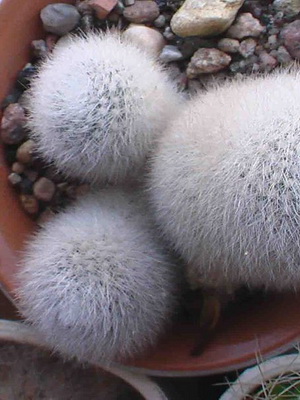
Rebution of the Muscle (R. muscula).
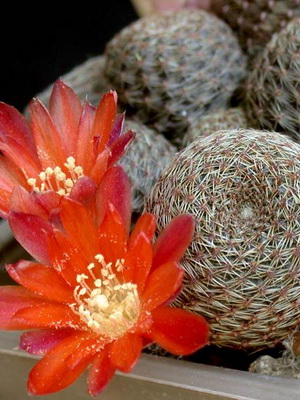
Ritter's rebution (R. ritterii).
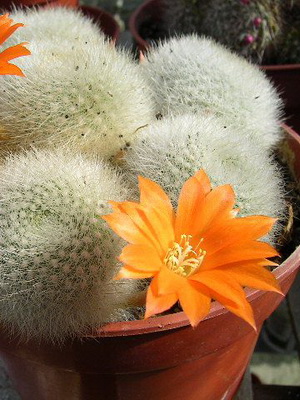
Excellent rebutia (R. pulchra).
The first type of unpretentious rebution looks unusual: the stem is formed by many small lateral processes that have a spherical shape. The white-flowered succulent is distinguished by abundant flowering: its petals have a delicate creamy shade with light pink tips. The size of the flower is 4 cm, and visually it often exceeds the volume of the stem itself.
The tiny rebutia has a juicy green stem that grows no more than 5 cm in height. On the stem of the cactus, there are proportionally tubercles with short creamy white spines. The flowers are bright red, small: they reach 4 cm in diameter.Take a look at the photo of this type of rebution: it looks minimalist and bright:
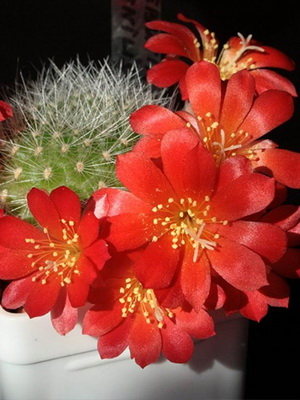

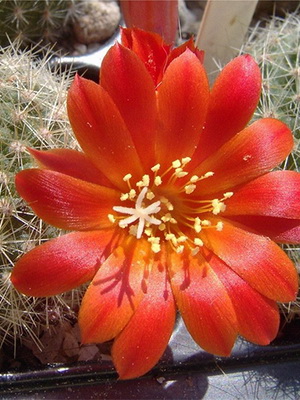
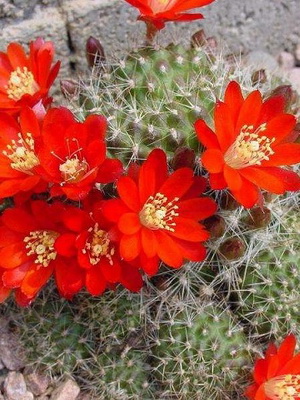
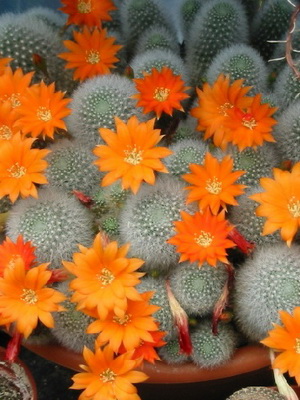
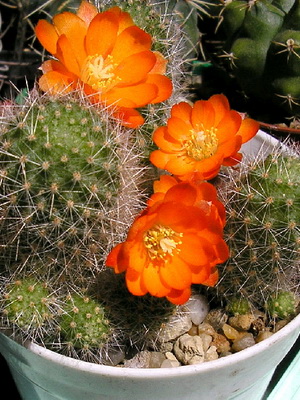
Rebutia "Solnechnaya" variety of succulent is one of the most popular for indoor cultivation. The height of a small cactus is 8 cm, and its diameter is 2-3 cm. The spines are also small, they grow up to 1 mm in length. The plant got its name due to the peculiarities of cultivation: this species needs a lot of sunlight. Red-orange flowers appear in summer from last year's halos, so the place of bud development can be seen in advance.
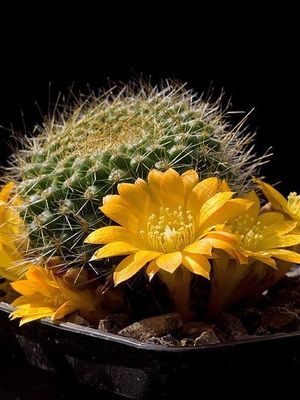
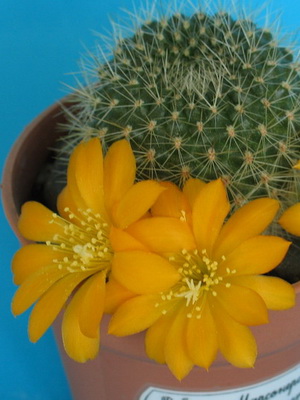
Among indoor flowers, a special place is occupied by the Marsoner variety. It has a spherical stem, on the sides of which buds appear. It is difficult to assess the beauty of this type of rebutia by description: in the photo you can see the spiral arrangement of tubercles and thorns, as well as a rich "canary" (yellow) shade of flowers that open at the same time:
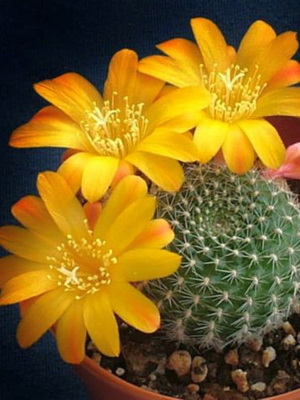
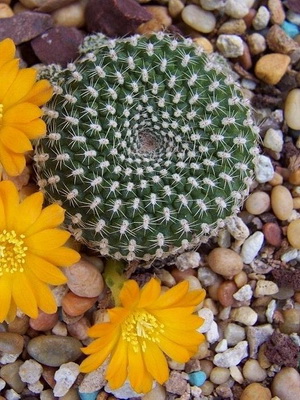


The Kupper variety is a small cactus of juicy green color, sometimes with a brown tint. The buds harmonize beautifully with the shade of succulent: the blossoming flowers have an orange-red or "wine" palette.
The muscle rebution also looks original: a photo of this cactus attracts attention with thick and thin white spines on its stem, which resemble fluff from afar:



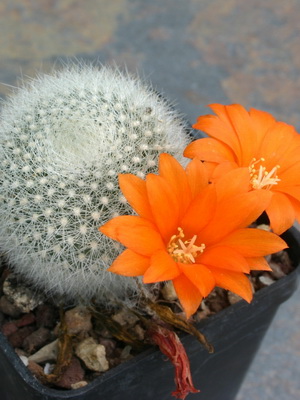
This feature became the reason for the appearance of the popular name of the variety - rebutia "mouse". Its flowers are orange in color and slightly elongated. The diameter of a fully open bud is 6 cm.
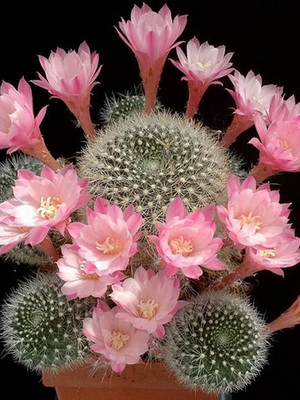
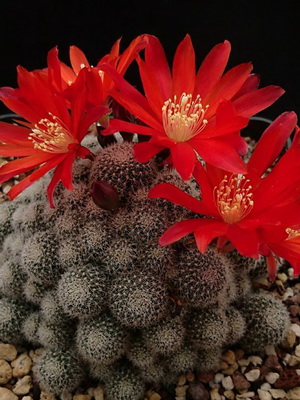
Indoor floriculture also often uses rebutia and the Ritter variety, named after the biologist who described the species.
To choose one of the species, look at a photo of an amazing rebution: unusual and abundantly blooming specimens will adorn the collection of any grower:
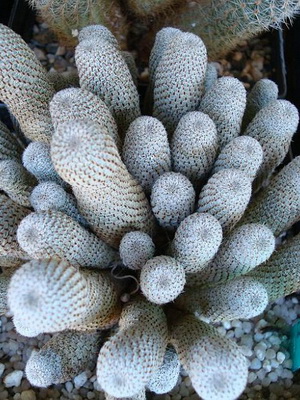

Proper care of the rebution
It is easy to care for a succulent, so a novice florist can also grow a flower at home. But there are several requirements for environmental conditions. Rebuts need a bright place, protected from the midday sun in summer. Oriental windows are ideal, near which you can place a succulent.
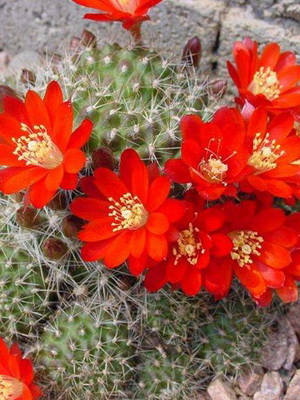

For a cactus, air humidity does not matter, but in the summer heat it is advisable to spray it with settled water at room temperature. At this time, the succulent should be in the shade or under the influence of indirect sunlight. Caring for rebutia at normal home conditions requires proper soil moisture. In the summer, regular watering is necessary, but it should be started only with the appearance of buds. They are guided by the moisture content of the upper soil layer: it should not dry out. In autumn (September - October), watering is gradually reduced. In winter, the soil is not moistened: the exception is young plants that grow no more than 2 years. Once or twice a month they are watered with a small amount of liquid without salt, and on sunny days from February-March, the substrate is sprayed with soft water.
In winter, the rebution is placed in a cool room where the temperature does not drop below 0 ° C. But at the same time, there must be good natural lighting.
When caring for rebutia in winter, it is worth remembering that too high air temperature during dormant months leads to the appearance of a large number of lateral shoots and deformation of the stem. After that, the flowering of the succulent may not come.
During the growing season, fertilizing is carried out with fertilizers for cacti. The main thing is not to exceed the amount of nutrients. The high nitrogen content in the soil causes the root of the plant to rot.
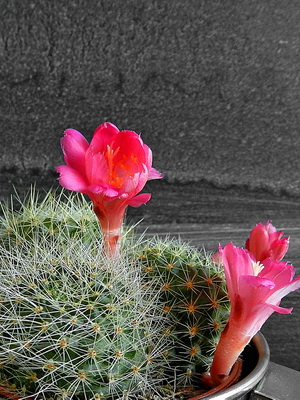
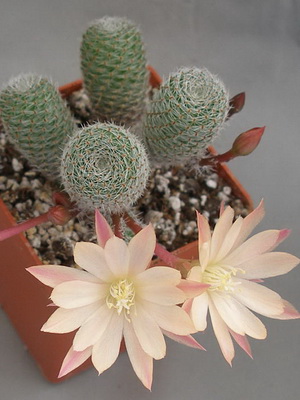
An integral part of rebution care is transplantation: for a cactus, this procedure is carried out in early spring as needed. But young succulents are transplanted annually. At the same time, the soil should be dry, and the transplanted plant should not be placed in direct sunlight.
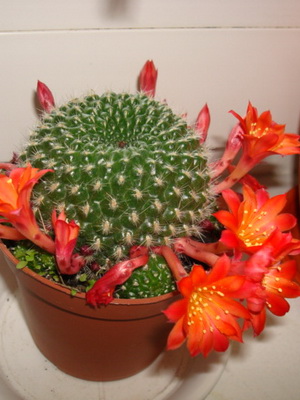
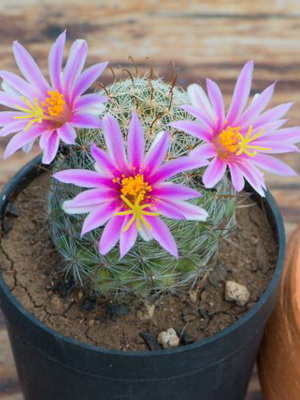
Rebutia blooms in spring or early summer.After flowering, the plant can be taken out into the air. The cactus will feel good on the terrace or balcony.




